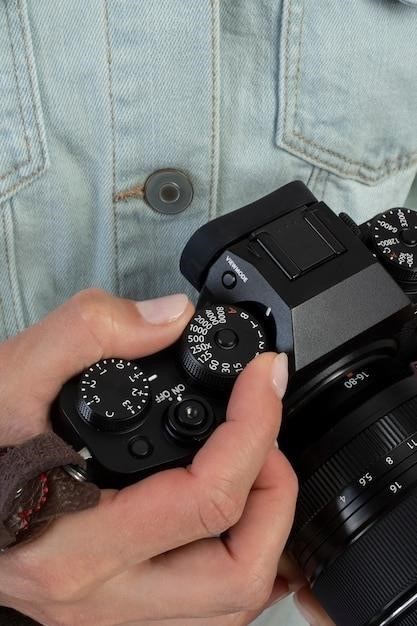Canon T50⁚ A Comprehensive Overview
The Canon T50, a 35mm SLR camera, offers a blend of automated features and manual control. Its built-in power winder allows for continuous shooting, while its advanced auto-exposure system simplifies photography. The manual focus and FD lens compatibility provide flexibility for experienced photographers.
Downloading the Canon T50 Instruction Manual
Numerous online resources offer the Canon T50 instruction manual for download. Several websites, including those specializing in vintage camera manuals, provide PDF versions. These digital copies are often free, although some sites may require a small fee or registration. Be cautious when downloading from unknown sources, ensuring the website is reputable to avoid malware or corrupted files. Always verify the file size and page count against the information provided on the site to ensure you are downloading the correct manual. The manual is typically available in English, but other languages may be offered depending on the source. Remember to check the file’s integrity after download to avoid frustration later. A reliable PDF reader, such as Adobe Acrobat Reader, is necessary to view the manual correctly. The size of the file is usually around 1.75 MB and consists of approximately 33 pages. Before downloading, make sure you have sufficient storage space available on your device. Always exercise caution when downloading files from the internet.
Availability and Formats of the Manual
The Canon T50 instruction manual is readily accessible in various formats and through different channels. Primarily, it’s available as a downloadable PDF file, easily found on numerous websites dedicated to camera manuals and online archives. These digital versions offer convenience and accessibility, allowing users to access the manual anytime, anywhere. Some websites may offer the manual for free, while others may charge a small fee. Additionally, physical copies might be obtainable through online marketplaces such as eBay, or from sellers specializing in vintage camera equipment. These physical manuals might be in better condition than scanned copies and offer a more tactile experience, although availability and condition can vary. The quality of the digital copies can also vary; some scans may be clearer and easier to read than others. It’s recommended to check reviews and compare different sources before downloading or purchasing.
Manual Specifications⁚ Size and Pages
The Canon T50 instruction manual’s physical dimensions and page count can vary depending on the version and source. Digital versions, commonly found as PDF files, are easily adjustable in size to fit various screen resolutions. However, the original printed manual typically comprised a substantial booklet. Reports suggest a common file size around 1.75 MB for digital versions. The number of pages is consistently cited as approximately 33 pages, though slight variations might exist due to different printing versions or additions of supplementary information by certain distributors or websites. The page count reflects a comprehensive guide covering camera operation, features, and troubleshooting. It is important to note that the physical size will depend on the original printing specifications which are not consistently reported online. The digital versions can be easily scaled to fit any user’s needs, though some clarity may be lost when greatly enlarging a low resolution scan.

Understanding the Canon T50’s History and Design
Released in 1985, the Canon T50 aimed to revitalize SLR sales with increased automation. It featured a built-in power winder and programmed auto-exposure, yet retained manual focus and FD lens compatibility.
The Canon T50’s Place in SLR History
The Canon T50 holds a significant position in the history of 35mm single-lens reflex (SLR) cameras. Introduced in 1985, it marked a pivotal moment for Canon, as SLR sales were declining. The company strategically responded by incorporating greater automation into its SLR offerings, mirroring the success seen in its compact camera lines like the AF35M Autoboy (in Japan) and Sure Shot (in the US). This decision to blend advanced technology with user-friendly operation was a key factor in the T50’s design and subsequent market reception. The camera’s built-in features, such as the power winder enabling continuous shooting at 1.4 frames per second and the sophisticated auto-exposure system, were intended to attract a wider range of photographers, from beginners to more experienced users. Its place in history is cemented not only by its technological advancements but also by its contribution to Canon’s continued competitiveness within a changing market landscape for SLR cameras. The Canon T50’s design reflects this strategic shift towards more accessible and automated SLR photography.
Key Features⁚ Auto-Exposure and Power Winder
The Canon T50 boasts two standout features that significantly enhance its usability⁚ a sophisticated auto-exposure system and a built-in power winder. The programmed auto-exposure mode simplifies the process of setting exposure parameters, making it ideal for photographers of all skill levels. This automation eliminates the complexities of manual adjustment, allowing users to focus on composition and capturing the moment. The auto-exposure system intelligently considers various factors such as lighting conditions and film speed to determine the optimal shutter speed and aperture. Complementing the auto-exposure is the integrated power winder, a notable feature for its time. This mechanism allows for continuous shooting at a rate of 1.4 frames per second. This capability is invaluable for capturing fast-paced action sequences or ensuring that a desired moment is not missed. The combination of automated exposure and continuous shooting capabilities makes the Canon T50 a remarkably versatile camera for diverse photographic applications.
Manual Focus and Lens Compatibility
Despite its automated features, the Canon T50 retains the classic manual focus mechanism favored by many photographers. This allows for precise control over the point of focus, a crucial element in achieving sharp, well-defined images. The manual focus ring on the lens provides tactile feedback, enabling photographers to fine-tune their focus with accuracy. This manual approach offers a level of control and precision that some photographers prefer over autofocus systems. Furthermore, the Canon T50’s compatibility with Canon FD lenses significantly expands its capabilities. The FD mount, a long-standing Canon system, offers a vast selection of lenses, each with its own unique characteristics and focal lengths. This wide range of lenses allows photographers to adapt their equipment to a variety of shooting situations and creative styles. From wide-angle landscapes to telephoto portraits, the Canon T50’s lens compatibility makes it suitable for a wide array of photographic endeavors. This combination of manual focus and extensive lens compatibility provides photographers with remarkable creative control and versatility.

Using the Canon T50⁚ A Step-by-Step Guide
This section details essential steps⁚ loading film and batteries, setting film speed and exposure, and mastering basic camera operation for optimal shooting techniques.
Loading Film and Batteries
Before embarking on your photographic journey with the Canon T50, ensure you have the necessary components readily available. Begin by acquiring two fresh AA-size 1.5V batteries; alkaline-manganese (LR6) batteries are recommended for optimal performance. Insert these batteries into the designated compartment, ensuring correct polarity as indicated within the battery chamber. The camera’s instruction manual provides clear visual guidance to prevent any mishaps. Next, load your 35mm film cartridge. Open the back of the camera, ensuring the film advance lever is in its resting position. Insert the film cartridge into the designated slot, ensuring the film leader is correctly positioned against the take-up spool. Close the back of the camera carefully. Advance the film using the film advance lever until the shutter is cocked and the frame counter displays “1.” Refer to the detailed diagrams in your Canon T50 instruction manual for a step-by-step visual guide. This careful preparation will ensure smooth operation and prevent costly errors.
Setting Film Speed and Exposure
To achieve optimal results with your Canon T50, accurately setting the film speed (ISO) and exposure is crucial. Locate the ISO dial, typically found on the top of the camera body near the shutter speed dial. Match the ISO setting on this dial to the ISO rating of the film you’ve loaded. This ensures correct exposure calculations by the camera’s metering system. The Canon T50 offers a programmed auto-exposure (AE) mode, simplifying the process. In this mode, the camera automatically determines the appropriate shutter speed and aperture based on the chosen ISO and available light. However, understanding the basics of exposure is helpful. Exposure is determined by the interplay of aperture (lens opening), shutter speed (duration the shutter is open), and ISO (film sensitivity). In brighter conditions, a faster shutter speed or smaller aperture is needed. Conversely, in low light, a slower shutter speed or wider aperture is necessary. The Canon T50’s instruction manual provides detailed explanations and examples to guide you through these settings. Mastering these fundamentals will enhance your photographic skills and image quality.
Basic Camera Operation and Shooting Techniques
Operating the Canon T50 is intuitive, even for beginners. After loading film and batteries, ensure the film speed is correctly set. Hold the camera firmly, using both hands for stability. Compose your shot through the viewfinder, focusing on your subject. The Canon T50’s manual focus requires you to adjust the lens’s focus ring until the image is sharp. With the subject in focus and composition finalized, gently press the shutter release button halfway to activate the camera’s metering system. This allows the camera to measure the light and determine the appropriate exposure settings in programmed AE mode. Fully depress the shutter release button to capture the image. Experiment with different angles and perspectives to enhance your shots. Remember to avoid camera shake by holding it steady, and consider using a tripod or monopod for long exposures or telephoto lenses. Practice is key to developing your skills and understanding how the T50’s features work together to create well-exposed, sharp images. The instruction manual provides further tips and techniques.
Troubleshooting and Maintenance
Consult the Canon T50 instruction manual for common issues and solutions. Additional resources and support are available online and through camera repair specialists. Regular cleaning and careful handling will extend the camera’s lifespan.
Common Issues and Solutions
The Canon T50, while robust, can experience typical camera malfunctions. A common problem is battery-related. Ensure you’re using fresh, correctly-installed AA batteries. If the camera fails to power on, check the battery compartment for corrosion or obstructions. Another issue might involve film loading. Refer to your instruction manual for the precise film-loading procedure to prevent jams. If a jam occurs, carefully rewind the film according to the manual’s instructions to avoid damaging the film or the camera mechanism. Exposure problems can stem from incorrect film speed settings or malfunctioning light meters. Double-check the film speed dial setting against the film canister information. If the automatic exposure seems inaccurate, try shooting with different light sources. Remember, the manual provides detailed troubleshooting steps for various issues. If problems persist after attempting the solutions in the manual, consider seeking professional repair service from a qualified camera technician.
Accessing Additional Resources and Support
Beyond the Canon T50’s instruction manual, several avenues exist for troubleshooting and support. Online forums dedicated to vintage cameras often feature discussions on common Canon T50 problems and solutions; Experienced users frequently share their repair experiences and troubleshooting tips. Websites specializing in camera manuals, such as Mike Butkus’s online library, offer downloadable PDF versions of the instruction manual in various languages. This can be especially helpful if your original manual is damaged or missing. Searching online for “Canon T50 repair” will reveal local camera repair shops or technicians skilled in repairing older SLR cameras. Remember to check reviews before choosing a repair service. YouTube also offers video tutorials on various aspects of using and maintaining the Canon T50. These videos can provide visual guidance for tasks like film loading, battery replacement, and basic camera operation. Utilizing a combination of these resources increases your chances of successfully addressing any issues you encounter with your Canon T50.



0 Comments